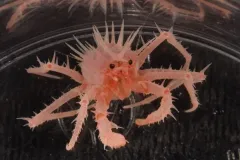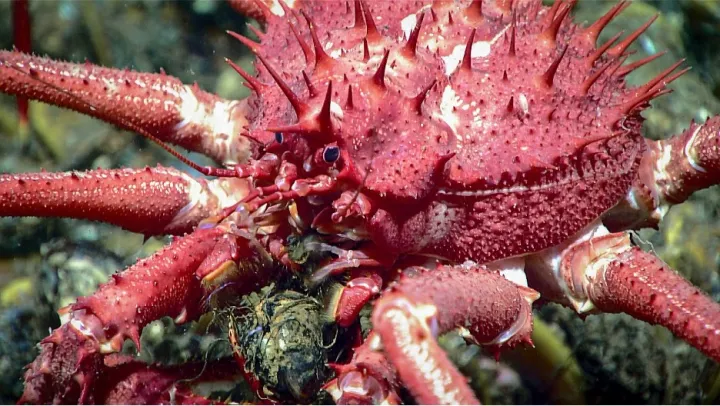Tiny Crab Gains a Big Audience

During a deep-sea restoration mission off the coast of Louisiana, a remotely operated vehicle (ROV) taking images of the seafloor and collecting specimens plucked a plastic bag from off the bottom and placed it in a collection box. Once the ROV had surfaced and returned to its ship, the restoration team found a tiny hitchhiker had likely come up with the bag - a crustacean about the size of a quarter. The crab was picked up by the purple-gloved hand of a scientist and garnered a crowd of admirers. With its tiny black eyes and miniscule claws clasped over its spiked body, it looked almost bewildered, unsure of how it came to be in such an unfamiliar place surrounded by such unfamiliar faces.
Those on the ship were not the only ones to find this crab endearing. When a video of the crab was published online by the National Oceanic and Atmospheric Administration (NOAA) it garnered millions of views, thousands of likes, and even inspired fan art. Many people fell in love with the tiny crab plucked from the seafloor and wanted to know more about it and its fate.
The crab was collected as a part of a larger effort to support the restoration of deep seafloor habitats, including a zone called the mesophotic, that were impacted by the Deepwater Horizon oil spill. This restoration work, led by NOAA and the Department of the Interior, involves spending many days at sea each year to complete crucial field work to inform and conduct research activities. This particular mission involved removing invasive lionfish and marine debris, testing out techniques for growing corals, and collecting sediment, water, and biological samples to characterize the diversity of mesophotic and deep seafloor habitats. Smithsonian scientists supported this mission and other restoration efforts by providing the expertise needed to identify and characterize the biological diversity of areas impacted by the spill as well as areas nearby that were not impacted. By collecting sea creatures like crabs, corals, sponges, and mollusks from these areas, scientists can accurately identify and describe all the life that contributes to a healthy deep seafloor ecosystem to ensure successful restoration.
After the crab’s collection, it was sent to the Smithsonian National Museum of Natural History (NMNH) where it was identified as a juvenile from the king crab species Neolithodes agassizii. This species belongs to the family of crustaceans Lithodidae, which includes over 100 different species of king crabs, including the more familiar commercially caught red king crab. King crabs live mostly in deep cold waters and grow to be some of the largest arthropods (the group that includes insects, spiders and crustaceans) on Earth. While the juvenile that was picked up was less than an inch long, adult N. agassizii can grow to be to be several feet in length.
Besides its captivating presence, this crab can teach scientists important information about the biology, life history, and even the ecology of the species. The deep seafloor habitats where this species lives are hard to access and historically understudied. For Mark Lehtonen, a technician in NMNH’s Department of Invertebrate Zoology, collecting specimens and bringing them back to the museum is an opportunity to better understand these habitats. “Any time you collect an animal you are adding to the body of knowledge about that species and its ecosystem. We refine our understanding of where the species is found and at what depths. This can be particularly valuable information when you collect less commonly seen life stages, like this juvenile crab.” In marine invertebrates the adults and young don’t always live in the same place and sometimes don’t even look the same. By collecting specimens like this juvenile crab, museum experts can correctly identify it, collect tissue samples for genetic analysis, and use the information gathered to inform restoration and management decisions.
The collected crab will not only help enlighten current restoration efforts, but it will join over 148 million other items in the National Museum of Natural History’s collection and help inform future science. In 50, 100, or even 400 years there might be a new oil spill or ocean conditions might change, giving rise to new questions about the health of deep seafloor ecosystems. Scientists in the future will be able to use the museum’s vast and growing collection to answer those questions. This N. agassizii will still be the museum's collection as physical proof of what life was like in the deep waters off the coast of Louisiana in 2024. And, maybe this little crab will captivate and excite future minds the way it does now.


